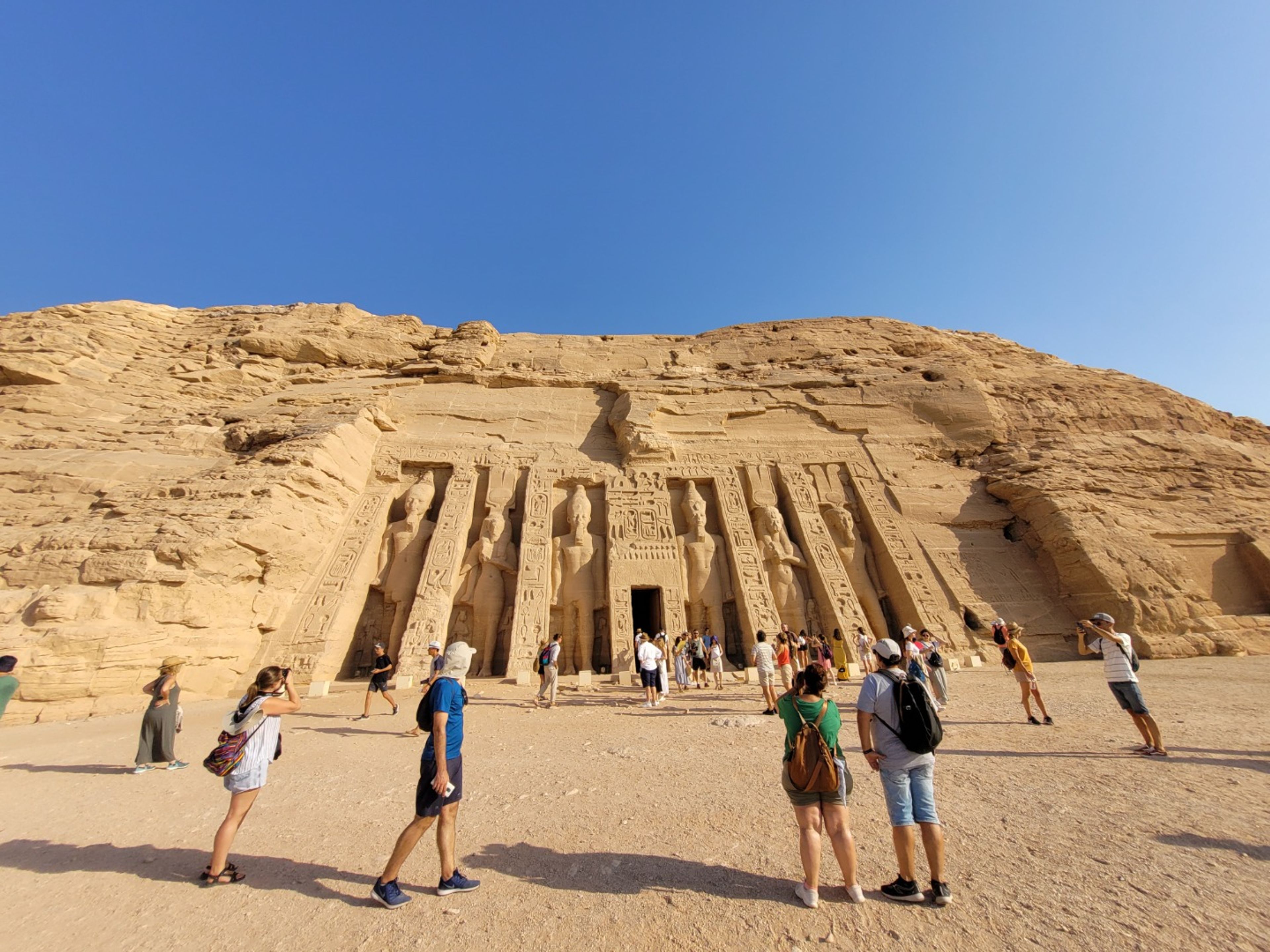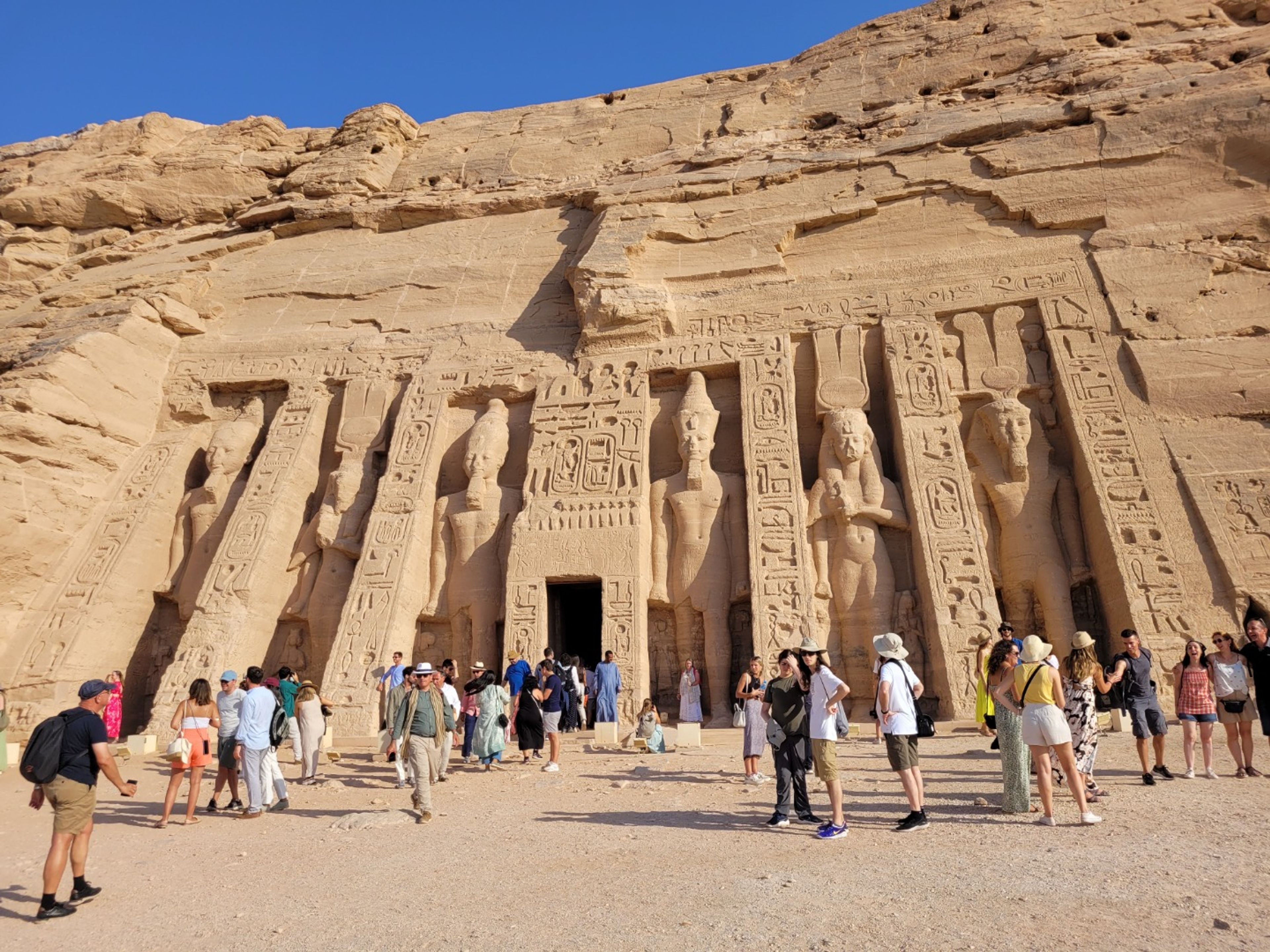"FULL DAY TOURS IN THE TEMPLE OF ABU SIMBEL" Private Tour





"FULL DAY TOURS IN THE TEMPLE OF ABU SIMBEL" Private Tour
THE TEMPLES OF ABU SIMBEL – THE EIGHTH WONDER OF THE WORLD: Few places on Earth inspire as much awe and reverence as the Temples of Abu Simbel, one of Egypt’s greatest treasures and a true architectural masterpiece of the ancient world. Rising majestically from the golden sands of Nubia, near the border with Sudan, these monumental temples — carved directly into the mountainside — were built more than 3,200 years ago by the mighty Pharaoh Ramses II, the most powerful ruler of the New Kingdom. The complex consists of two breathtaking temples: the Great Temple of Ramses II, dedicated to the gods Amun-Ra, Ra-Horakhty, and Ptah — as well as to Ramses himself — and the Small Temple of Nefertari, devoted to the goddess Hathor and the pharaoh’s beloved queen, Nefertari. Together, they stand as an eternal symbol of power, devotion, and divine artistry. The façade of the Great Temple is one of the most iconic sights in Egypt — four colossal statues of Ramses II, each soaring over 20 meters high, guard the entrance with an air of timeless majesty. These awe-inspiring figures were meticulously carved into solid rock, gazing eternally toward the rising sun. Inside, a sequence of vast chambers and sanctuaries adorned with vivid reliefs and colossal statues narrate the victories and divine relationship of the pharaoh with the gods. The atmosphere inside is nothing short of mystical — a silent dialogue between man, art, and eternity.
Perhaps the most extraordinary feature of Abu Simbel is its astronomical alignment. Twice a year — on February 21 and October 21 — the rays of the rising sun penetrate the temple’s inner sanctuary to illuminate the statues of Ramses and the gods seated beside him, leaving the figure of Ptah, the god of darkness, in shadow. This miraculous event, achieved through ancient engineering precision, continues to amaze visitors and scholars alike. Just beside it stands the Temple of Nefertari, smaller in scale yet equally magnificent. Its façade is adorned with six statues carved into the rock, four of Ramses II and two of his beloved queen — one of the few instances in Egyptian art where a female figure is represented on the same scale as the pharaoh himself. The temple’s interior is beautifully decorated with vibrant reliefs depicting Nefertari worshipping Hathor, symbolizing love, music, and fertility. In the 1960s, when the construction of the Aswan High Dam threatened to submerge these wonders under the rising waters of Lake Nasser, a historic rescue operation — led by UNESCO — was undertaken. In an astonishing feat of modern engineering, the temples were dismantled and relocated stone by stone to higher ground on the nearby plateau of Abu Simbel, preserving them for future generations.
Today, visiting Abu Simbel is far more than a journey into Egypt’s glorious past — it is a spiritual encounter with the genius, power, and enduring legacy of an ancient civilization that defied time and nature itself. As you stand before these colossal statues, bathed in the golden light of dawn, you’ll understand why Abu Simbel is often called the Eighth Wonder of the World — a place where history, art, and eternity converge.
Itinerary
-
Depart early in the morning from your hotel or cruise ship in Aswan aboard a modern, air-conditioned coach, and enjoy a comfortable drive through the golden desert landscapes of Nubia.
-
Upon arrival, marvel at the majestic Temples of Abu Simbel, masterpieces of ancient Egyptian architecture carved directly into the mountainside over 3,000 years ago. Accompanied by your expert English-speaking Egyptologist guide, discover the fascinating history behind these colossal monuments built by Pharaoh Ramses II in honor of himself and his beloved wife Queen Nefertari.
-
Take your time to explore both temples at your own pace, admiring the towering statues, intricate carvings, and perfectly aligned sanctuaries that continue to amaze visitors from around the world.
-
After this unforgettable experience, relax and enjoy the scenic drive back to Aswan, carrying with you the memory of one of Egypt’s most impressive and awe-inspiring ancient wonders.
-
All visits to the different facilities and museums have the presence of a specialist who will guide our tour, explaining in detail the meanings and history of the different attractions that we can observe.
The tour includes
- Spanish-speaking guide service.
- Visit to The Temples of Abu Simbel.
- All transfers from and to the hotel or airport in modern, air-conditioned private coaches.
- All information on all the aforementioned visits.
- Special treatment and elite service.
The tour does not include
- Professional guide in English, French, Portuguese, German and Italian languages. If you want a guide in these languages, it is done on request and an extra charge must be paid.
- Extras not mentioned in the program.
- Personal expenses and tips.
- Breakfast, Lunch and drinks during visits.
• It is recommended to wear light clothing, sunglasses, caps or hats, sneakers or sandals, sunscreen, and a camera. • It is recommended to bring at least a bottle of water, light meals with sweets, and snacks.
More Information
- 8 hrs aprox
- 04:00 hrs
- Tour guide included
- Family friendly
- Offered inSpanish
Options and Availability
Private tour (from 2 to 5 pax)
Private tour with exclusive guide service in your language. Pick-up time and itinerary tailored to your interests.Private tour (from 6 to 20 pax)
Private tour with exclusive guide service in your language. Pick-up time and itinerary tailored to your interests.Policies and Conditions
- This tour operates with a minimum of 2 passengers, Holiplus will reconfirm 48 hours before departure. If the supplier decides to cancel, for reasons of force majeure or adverse weather conditions, Holiplus will offer an alternative tour or will fully refund the cost of your trip.
- Rates are expressed in US dollars (USD) and may be changed without prior notice.
- The services and programs can be changed or canceled in their execution, sequence and content; in order to offer a better service, or due to extreme conditions or force majeure reasons.
- The client must be aware that modifications in the original reservation may generate changes in the final price.
Cancellation and no show policy:
- Cancellations more than 72 hours before the excursion: No penalty applies.
- Cancellations between 72 hours and 48 hours before the excursion: a penalty of 25% of the total value of the excursion applies.
- Cancellations less than 48 hours before the excursion: a penalty of 50% of the total value of the excursion applies.
- NO-SHOW: a penalty of 100% of the total value of the excursion applies.
- Reservation fees and credit card surcharges cannot be refunded in case of cancellation.